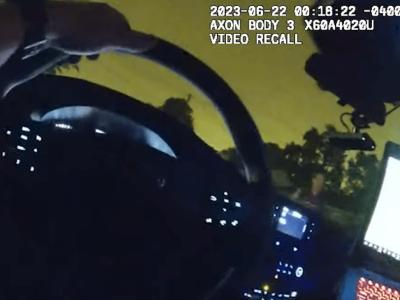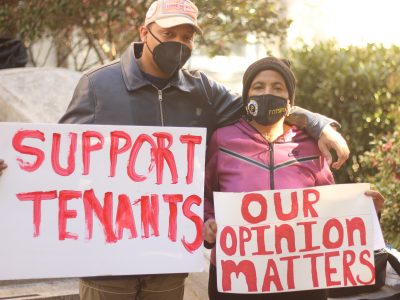Written by Eric Ginsburg, photos by Caleb Smallwood
Additional documents obtained by Triad City Beat confirm the connection between the quiet assembly of a police “civil emergency unit” and the 2012 Democratic National Convention and shed some light on the cost of the unit. Meanwhile, activists call for the team to be disbanded at a midnight march.
The decision to staff and train a police civil emergency unit that is “well prepared to respond to civil emergencies” came after the Greensboro Police Department assisted with the 2012 Democratic National Convention in Charlotte, department spokesperson Susan Danielsen said.
But the idea also made sense because police personnel received specific gear and equipment associated with the convention that could be put to use, police emails from the time show.
Triad City Beat uncovered the existence of the department’s civil emergency unit in December, about a year after the police department assembled a team of up to 90 officers. Two Greensboro City Council members, who act as chair and vice chair of the council’s public safety committee, said they had either no knowledge of or recollection of being briefed on the unit. (The council committee formed in September, but both council members have served since before the unit’s assembly.)
After discovering the unit through documents obtained in a public-records request, Triad City Beat filed additional requests. Several internal police department emails confirm that the Democratic National Convention played a significant role in the assembly of the civil emergency unit.
A Sept. 29, 2013 email from Capt. Joel T. Cranford to then-Deputy Chief Wayne Scott — now the police chief — sought approval for the unit. In a draft memorandum, Cranford wrote: “The equipment provided to the department’s personnel during the Democratic National Convention in Charlotte will serve as the initial allotment of gear for the newly constituted unit. At present, the department should have approximately 59 complete sets of field force gear for re-issue. Additionally, the department has an adequate amount of bicycles and protective bike gear in its current inventory to support the creation of the mobile bicycle component of the CEU.”
Almost a year later, Capt. John Wolfe sent out an email with a survey for those interested in joining the unit that also confirms the role of the Democratic National Convention in the unit’s formation.
The application, due by Sept. 17, 2014, only asked a few questions of officers. After asking for their names, ranks and current assignments, the survey said: “Were you deployed to Charlotte to assist with the DNC?” followed by, “If you were deployed to the DNC, what was your role?” The only additional questions asked for any special certifications officers held, if they were members of a special team and if so what, and whether the officers taught “in the PBIC or during in-service training” and if so what.
In the aftermath of the convention, starting a civil emergency unit in Greensboro also seemed like an attractive prospect from a financial perspective.
“Since a large majority of unit personnel will be outfitted with the uniform and protective gear provided through our participation in the Democratic National Convention, the initial start-up expenses relating to equipment are considered cost neutral,” Cranford wrote in the same September 2013 memorandum.
However, the unit would involve internal costs due to training. Based on the proposed configuration of 10 sergeants and 80 officers, and using the 2013 average costs for those ranks, Cranford estimated the total expense.
“Utilizing the current staffing levels and hourly rates the department can expect to incur 2,880 hours of training time away from their primary assignments, which equates to $65,177 in personnel costs associated with the creation of the unit,” he wrote.
He based the figure on “4 eight-hour training days per calendar year,” noting that “the cost figures could fluctuate depending on changes associated with scheduled and pre-event training needs identified by the organization.”
Cranford’s memorandum had proposed “quarterly training sessions” for the civil emergency unit — thus the four trainings a year mentioned in costing estimates. But the unit ended up training on a monthly instead of a quarterly basis, Danielsen said. It is unclear what if any impact the increased training regimen has on the overall cost of the unit.
Danielsen provided answers to some but not all questions about the cost of the unit via email on Dec. 31 and Jan. 5.
“We have not yet set about establishing a budget or reviewing the cost of training,” she wrote in her first email. “As the SOP requires a percentage of attendance based on available training days, that number is fluid. Otherwise there are some start-up costs that we have yet to receive. In the long term, the greatest expense will be training time. Funds are most likely from the general budget.”
In response to questions about how the start-up costs are deferred, whether average costs for sergeants or officers has changed since 2013 and questions about the overall cost of the unit, Danielsen wrote: “No additional personnel costs are incurred as a result of training. Officers called out for an event or scheduled to work an event may be entitled to overtime. This cost varies based on the length of the assignment, the number of people dedicated to the event, and their salaries.”

©
In his 2013 memorandum, Capt. Cranford pointed out the ability to deploy the unit outside of the city.
“The benefits associated with having an organized and trained civil emergency unit is the department will have a standing unit readily deployable in the event of localized civil unrest and disobedience,” Cranford said. “Furthermore, it provides a unit that can deploy and represent the organization at major functions such as the presidential inauguration, as well as the political conventions occurring regionally and nationally if request [sic] to assist.”
But Danielsen said the unit has only been used locally so far — “to keep the peace a dozen times in 2015” — and said that those instances “were partial activations, meaning only a portion of the team was used each time.”
Revelations about the unit’s existence frustrated some residents, who argue that it contradicts the public image the Greensboro Police Department is trying to project with things like the new Community Engagement Office and a traffic-stop reform in the wake of the October 2015 New York Times investigation into disparate policing practices in Greensboro.
At a midnight march on Jan. 1, not long after Triad City Beat discovered the civil emergency unit, Greensboro Black Lives Matter participants including organizer April Parker issued a list of demands that included the dissolution of the unit.
Join the First Amendment Society, a membership that goes directly to funding TCB‘s newsroom.
We believe that reporting can save the world.
The TCB First Amendment Society recognizes the vital role of a free, unfettered press with a bundling of local experiences designed to build community, and unique engagements with our newsroom that will help you understand, and shape, local journalism’s critical role in uplifting the people in our cities.
All revenue goes directly into the newsroom as reporters’ salaries and freelance commissions.





So Eric, why aren’t you writing about the Mayor and City Council’s involvement in this civil emergency unit?
The article fails to explain the significance, if any, of the relationship of the CEU to the 2012 Democratic National Convention in Charlotte.
Eric fails to explain a lot like the Mayor and City Council’s involvement.
From https://triad-city-beat.com/police-quietly-prepare-for-a-riot/, which should at least partially answer your question, Billy.
There’s a lot about that in the first seven grafs, Lex.